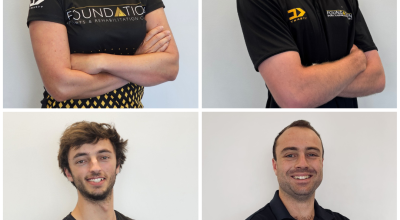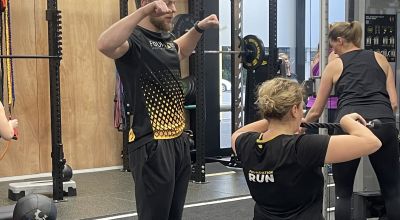An anterior cruciate ligament (ACL) injury is a significant knee injury which can result in considerable time out of sport. The purpose of the Foundation Clinic protocol is to give a guideline to what to expect through the rehabilitation journey.
The first step in the process is the initial consult. If an ACL is suspected, your physio will refer you onto a specialist or surgeon who will be able to order an MRI scan of your knee.
Once an ACL diagnosis is confirmed, your medical team, including physiotherapy will talk you through the potential options of rehabilitation. The most common approach for ACL rehabilitation is surgery using either a patella or hamstring graft to replace the torn ACL. However, there is also growing evidence that individuals can successfully rehabilitate back to full function including pivoting sport without having to have a reconstruction. Your surgeon and physio will talk you through both processes and factors which might influence the decision making to help achieve the best approach and outcome for you.
Progression of ACL rehabilitation is influenced by multiple factors. Progression is usually function/goal driven and not time based. This protocol is designed to give you a guide around what functional goals are needed to help achieve a successful return to activity. Factors such as age, gender, previous level of function and goals of the individual all influence the structure of the rehabilitation program, which well be tailored to each individual. Even though progression through the protocol is function based, consideration must also be given to the healing of the graft to ensure this is adequately healed and is up to taking the demands of the physical tasks. There is evidence showing that every month return to sport is delayed up to 9 months post-surgery can decrease the re-rupture chance by 51%. With another study showing that young athletes who went back prior to sport at 9 months had a 7x greater risk of sustaining another knee injury.
Running and hopping (plyometrics) can usually be added into the rehabilitation program at about 4-6 months. However, this is dependent on meeting the physical requirements and control required. Unfortunately, worldwide the re-rupture rates are typically high and can be as large 21%. Young athletes and females are at greater risk of rupturing the graft, so ensuring good function and passing the RTP criteria can help decrease the risk of rupture and help ensure less impairment longer time being involved in sport and activities.
Below is a guideline of the multiple steps involved in navigating a successful ACL rehabilitation with the goals of each outlined below:
- Pre-Op Phase: Injury recovery and readiness for surgery
- Phase 1: Post-Op recovery
- Phase 2: Control and capacity
- Phase 3: Strength and accumulation
- Phase 4: Sport preparation
- Phase 5: Return to play and maintain performance
Pre- Surgery Stage:
The purpose of the stage is to get individuals ready both physically and mentally for surgery. Your physio will take you through a rehabilitation program to help build up lower limb strength along with working on neuromuscular control of the knee. Research has shown that individual who complete a 10-12 week of ‘prehab’ prior to surgery have better functional outcomes of their knee post-surgery and greater success in return to sport.
In this step some individuals will be able to get back to nearly full function and might choose to delay their surgery to see if they can successfully rehab without needing surgery. Your physio will take you through functional testing, designed to highlight those clients that might “cope” without surgery. This testing also gives great information to use as a baseline rehab measure post-surgery.
This stage also allows us to pick up on any compensatory strategies or weakness that may have contributed to your injury or that might help in navigating a successful rehab. If you are part of a team environment working with a strength and conditioning coach or other coaches, they might be involved in helping to work on other aspect of your training to help keep you sport fit.
Post-Op Recovery - Phase 1:
The main goals straight after surgery is calming the knee. The knee will be swollen, stiff and sore following surgery.
Your surgeon will talk you through the immediate recovery and will supply medication as required. Your physio will talk you through initial exercises to help increase range of motion of the knee, decrease swelling and help to progress walking without any aids.
Control and Capacity – Phase 2:
This phase is about building awareness and control of your knee in a graduated and controlled manner. This step aims to gives you a great launching pad to be able to start activities requiring greater control and force absorption such as running and jumping.
The stage will typically involve gym work to help build back up muscle strength and coordination, along with identify and address compensatory strategies. Research has shown that whilst running approximately 4.5 to 6.5 x body weight (BW) of forces is absorbed through the knee. Building up control and strength of the knee is a crucial step to return to activities such as running.
Following surgery there will be deficit in strength both due to the harvesting of soft tissue for a graft along with an absence of activity. Restoring this balance is vital to a successful return to activity.
Strength Accumulation - Phase 3:
This phase of the rehabilitation process introduces running, impact and change of direction to the knee. This is done in a graduated method in a control, safe environment to ensure successful progression.
The emphasis of this phase is to ensure good awareness and control of the knee. This coupled with continued strengthening helps to form the strong foundation blocks to introduce sports specific movement and training in the next phase.
Sport Preparation Phase – Phase 4:
Athletes are now building into running, hopping and changing directions in both a controlled unpredictable environment. This phase is highly tailored to both the individual sport and position to help ensure all physical and mental goals are achieved.
Factors including age, gender, graft site and time will all be taken into account along with the functional control of the individual and sports demand.
Return to Play and Maintain Performance – Phase 5:
Athletes are now well into running, hopping and changing directions in both a controlled unpredictable environment. This phase is about incorporating sport specific movement back into rehab and integrating the athlete back into a sport/team environment.
Once you have been given the all clear from the medical team to return to sport it is important to keep fit and maintain your strength. Unfortunately rates of re rupture are very high in athletes which lead to individuals missing out on even more time from their sport or retiring completely.
For more information on the Foundation Clinic ACL Protocol email [email protected], or phone 07 579 5601.
Related posts

Congratulations to the winners of the 2025 Foundation Tauranga Awards!

Congratulations to the winners of the 2025 Foundation Hamilton Awards!

If you want faster recovery and long-term results, your rehab needs to look like the life you want to get back to.







